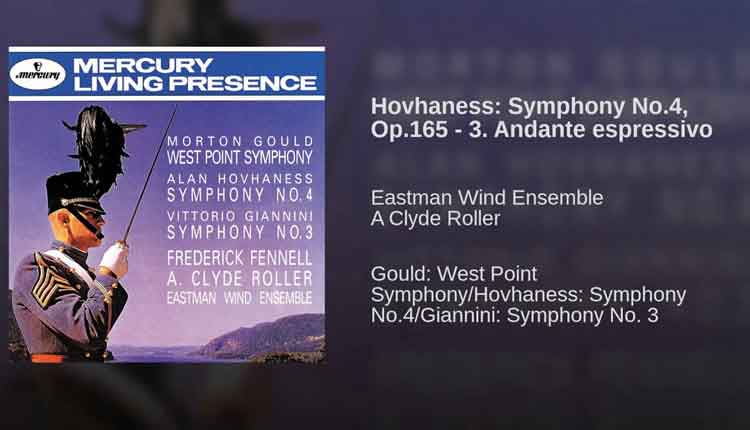Published by: C. F. Peters
Duration: 18 minutes
The American Wind Symphony Edition
Reviewed by: Vince Corozine
This composition brings forth a freshness of sounds and the absence of musical clichés. The composer is a superb artisan of the musical palette.
The instrumentation for this colorful work is:
3 or 6 flutes, 2 or 6 oboes, 1 or 2 English horns, 2 or 6 clarinets, bass clarinet, 2 or 6 bassoons, double bassoon, 4 or 6 horns, 2 or 6 trumpets, 4 or 6 trombones, tuba, harp, percussion (4 players) covering timpani, tam tam, glockenspiel, bass drum, marimba, xylophone, chimes, vibraphone, and gong. further specifications for particular percussion instruments are located on the inside of the full score.
This composition brings forth a freshness of sounds and the absence of musical clichés. The composer is a superb artisan of the musical palette.
The piece consists of three movements in the form of a concerto grosso with various solo instruments (even double bassoon and bass clarinet) acting as the concertante and a brass ensemble acting as the ripieno.
The chorale is sonorous, warm, full in impact, and richly endowed. The soli are colorful of, and faintly oriental.
The composer is a master of tonal color and he shows a remarkable ability to achieve unusual and fascinating sounds and effects. The crisp and intense combination of percussive instruments and winds is extraordinary.
The work opens slowly at MM-60, with warm-sounding trombones playing in four-part harmony, with the bass trombone supporting them. Splashes of percussive color enter after a four measure introduction. A sonorous pedal-point is established by the timpani, glockenspiel, marimba, and vibraphone.
A sultry bass clarinet solo emerges with an oriental tinged melody and continues for thirty measures while the sparse percussion and harp provide a pedal-point underneath.
A deep, woody double bassoon solo takes over during the next section and continues for thirty-two measures. A most unusual sound indeed. The same type of pedal-point continues below.
Three-part clusters in the flutes and clarinets, with the help of the bells and vibraphone leads effectively to a warm, mellow four-part horn chorale. It is to be noted that the composer makes use of the horns throughout most of the first movement for exactly fifty-three measures.
The next section is in fugato style MM=120-132. The composer uses the compositional technique of imitation to effectively combine four voices in the brass. Brass and woodwinds alternate throughout most of the section culminating on a fortissimo Eb major chord.
The second movement marked senzamisura is marked Allegro, and opens with an extended solo for the marimba followed by exotic effects in the percussion. The solo is mostly unaccompanied.
The composer is careful to use elided (overlapping) musical lines that smoothly connect the phrases. This is a very sophisticated musical practice. Beethoven referred to this as “smooth joins.” The movement ends quietly after an extended solo in the bassoon, over pedal-points in the horns, thereby achieving a movement with an unusual effect.
The composer’s solo sections are marked senzamisura (without tempo), and they may be freely interpreted by the soloists, such as the marimba or xylophone.
The third movement is a return of the warm chorale-style writing for the horns and tuba. It is to be noted the composer uses the tuba as the bass part for the horns, and the bass trombone for the bass of the trombone section. Perhaps the conical bore sound of the horns and the tuba creates a better blend than if the tuba were used on the lowest part.
The remainder of the movement is an alternating of sounds between the trombones, horns, and woodwinds. The ending builds to a fortissimo, again on an Eb major chord, with a dissonant solo Gb note played by the vibraphone.
This wonderful piece brings forth exotic sounds and fascinating tonal colors. Achieving a proper balance of tone between instrumental sections is a concern, in that they alternate melodic elements.
This is a mood piece with solos by unusual instruments, such as the marimba, xylophone, bass clarinet, and double bassoon. The technical demands are modest for most instruments, even though the horns must play for extended periods.
This 18-minute symphony can be used as a “color” piece to produce variety during a concert. The contrast and fascinating instrumental colors achieved by the composer, offer a piece that will be both unique in style and captivating in sound…
* The instrumentation for the Wind Symphony comprises three components: the normal percussion section of the symphony orchestra, plus symphony orchestra brass and woodwinds sections each of double size.
Vince CorozineMusic, Author of “Arranging Music for the Real World” by Mel Bay Publications
Web: www.vincecorozine.com
e-mail: vince@vincecorozine.com
(845) 208-3381
10 Veschi Lane North
Mahopac, NY 10541


